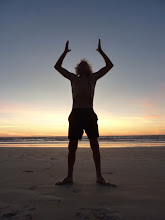Here are three paintings from the book Keringke: Contemporary Arrernte Art (Keringke Art, 1999). The Keringke group consists of a number of women artists from the eastern Arrernte peoples; their community is called Santa Theresa and is located about 90 kms southeast of Alice Springs in the Northern Territory of central Australia.
I first heard of them when I was in Alice in 2002. I had been going around to some galleries and showing them my hand-painted rocks. The manager of one gallery saw my rock and told me that I really had to go and meet the Keringke women, that we were doing the same kind of thing.
I rang to make sure it was ok to come, and made my way out into the beautiful desert area where their community is. Not many people were around, but I got to meet Sue Graham who was the director at the time, and Kathleen Wallace, the elder/leader of the Keringke artists.
I was blown away by their work. I couldn't believe the colour, the detail, the aliveness, the beauty of the fabrics, ceramics and canvasses they painted on. I could hardly believe that I was in the presence of art that was unlike that of any "modern" or "western civilization" artist, that spoke to me in ways totally beyond any words, as if it was a "language" of encoded information from the spirit of life or dna itself.
I showed Kathleen my rock (it was my one rock I had retained for a couple years, a kind of rainbow-flower mandala on a round white rock from the beach at Findhorn in Scotland. She loved it and told me that she couldn't believe that I used a brush to do this, as they don't use brushes at all, nor the traditional sticks, but little squeeze bottles with various sized tips!
I was just as impressed by Kathleen's presence as I was with their art; she probably spoke no more than a dozen words the whole time I was there, yet I felt a deep connection with her, a deep and real understanding, from one artist to another, that spanned any differences in personal reality.
I gave her a rock that I had brought, and she gave me a copy of their book. I was so inspired by this encounter that a few months later, in my studio in Hobart, I painted a large flat rock and thirteen little ones, in a completely new style that had come to me in Australia, a style which I call "Mullum-Keringke glyphs" ("Mullum" is short for Mullimbimby, a small progressive town in between Byron Bay and Nimbin, in the Wolumbin volcanic caldera, and where this new style of painting first came to me in 2000), and sent it to them as a gift to honour their unique creativity.
But the freakiest thing that came out of all this, and one of several major synchronicities that have happened with me in Australia, was that when I finally had a chance to look through the Keringke art book, I saw a painting that Serena Hayes had done in 1999, with six circles of dots (attachment 3). It was very similar to a painting I had done the same year, "Elohim Photon Dreaming", with seven circles of dots (attachment 4). I had done this painting after going into Joyce Kilmer Memorial Forest in extreme western North Carolina on the summer solstice of 1999 and meditating on my connection with nature and trees. I had learned that the ancient Druids had a name for a sacred grove of trees, a nemeton, and that the native Americans (the Cherokee reservation is only just over the hill from this old growth reserve) believed that the growing power of plants was at its greatest on the summer solstice.
When I saw Serena's painting I was blown away by the connection, that she and I had done practically identical paintings at about the same time on two different continents, without ever having seen or heard of each other, and then we were drawn to meet!
A couple years ago I asked my friend Robert Bednarik, who's probably the top rock-art researcher in the world, where he thought the most powerful place in the world is, in terms of Earth energy. Without pausing more than a second or two, he answered, "The Pilbarra."
Robert has traveled to and researched in dozens of countries; I trust his judgment.
I haven't been that many places, but western Australia and Australia as a whole in all her vast beauty and diversity is THE most absolutely wonderful and powerful place on this planet that I've yet to visit, with the possible exception of some of the volcanoes of southern Chile.
In places of power where the beauty and spirit of the land have not been stripped away by extractive capitalism to provide "nutrients" for the oncogenesis of industrial civilization you can still feel the true spirit of the Earth, of Mother Nature, of the dream-time ancestors, and of the indigenous people who still 'walk in beauty.' The Earth calls to us now, to awaken and to love her as she loves us!
Jeff Phillips
Leuven Belgium
July 2008
Monday, July 14, 2008
Subscribe to:
Post Comments (Atom)



No comments:
Post a Comment